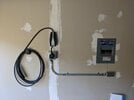Hi All,
I had an electrician come to the house and look at the garage panel. He said I have only 40amp coming into the garage panel from the house. His comment was I will be able to charge "just slower"
If I install the NEMA 14-50 outlet on the 40amp circuit then I can only draw 30amp from that outlet? (80% rule)
If you have a 50amp circuit I see people suggesting you can draw 40amp, to my understanding is the gen 2 14-50 adapter from Tesla only rated for 32amp? can you pull 40amp safely with that adapter? or is it locked to 32amp?
I'm looking at potentially getting a line run from the house panel instead and just plugging the car in outside ( not an issue as this is my temporary living for the next 2-3 years)
Upgrading the garage to 50 or 60amp is also not at option cost wise and with my living situation
I had an electrician come to the house and look at the garage panel. He said I have only 40amp coming into the garage panel from the house. His comment was I will be able to charge "just slower"
If I install the NEMA 14-50 outlet on the 40amp circuit then I can only draw 30amp from that outlet? (80% rule)
If you have a 50amp circuit I see people suggesting you can draw 40amp, to my understanding is the gen 2 14-50 adapter from Tesla only rated for 32amp? can you pull 40amp safely with that adapter? or is it locked to 32amp?
I'm looking at potentially getting a line run from the house panel instead and just plugging the car in outside ( not an issue as this is my temporary living for the next 2-3 years)
Upgrading the garage to 50 or 60amp is also not at option cost wise and with my living situation



